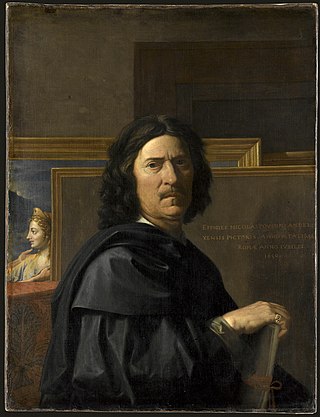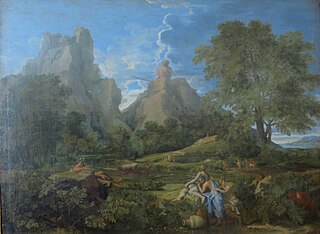Related Research Articles

Baroque painting is the painting associated with the Baroque cultural movement. The movement is often identified with Absolutism, the Counter Reformation and Catholic Revival, but the existence of important Baroque art and architecture in non-absolutist and Protestant states throughout Western Europe underscores its widespread popularity.

Nicolas Poussin was the leading painter of the classical French Baroque style, although he spent most of his working life in Rome. Most of his works were on religious and mythological subjects painted for a small group of Italian and French collectors. He returned to Paris for a brief period to serve as First Painter to the King under Louis XIII and Cardinal Richelieu, but soon returned to Rome and resumed his more traditional themes. In his later years he gave growing prominence to the landscape in his paintings. His work is characterized by clarity, logic, and order, and favors line over color. Until the 20th century he remained a major inspiration for such classically-oriented artists as Jacques-Louis David, Jean-Auguste-Dominique Ingres and Paul Cézanne.

Et in Arcadia ego is a 1637–38 painting by Nicolas Poussin (1594–1665), the leading painter of the classical French Baroque style. It depicts a pastoral scene with idealized shepherds from classical antiquity, and a woman, possibly a shepherdess, gathered around an austere tomb that includes this inscription. It is held in the Louvre.

Charles-Jean Étienne Gustave Nicolas, baron de la Vallée Poussin was a Belgian mathematician. He is best known for proving the prime number theorem.

Les Andelys is a commune in the northern French department of Eure, in Normandy.

Gaspard Dughet, also known as Gaspard Poussin, was a French painter born in Rome.
The Abhidharmakośabhāsya, Abhidharmakośa for short, is a key text on the Abhidharma written in Sanskrit by the Indian Buddhist scholar Vasubandhu in the 4th or 5th century CE. The Kośa summarizes the Sarvāstivādin Abhidharma in eight chapters with a total of around 600 verses and then comments on it. This text was widely respected and used by schools of Buddhism in India, Tibet and East Asia. Over time, the Abhidharmakośa became the main source of Abhidharma and Sravakayana Buddhism for later Mahāyāna Buddhists.
The family Delavallée Poussin, also denominated as de La Vallée Poussin, is a family of the French bourgeoisie coming from Normandy in France. Settled in Belgium since the end of the 19th century, most of its members still live there today. Two members of this family were ennobled in the 20th century by the king of Belgium.

Jacques Stella was a French painter, a leading exponent of the neoclassical style of Parisian Atticism.

Landscape with Polyphemus is a 1649 oil painting by French artist Nicolas Poussin.

The Four Seasons was the last set of four oil paintings completed by the French painter Nicolas Poussin (1594–1665). The set was painted in Rome between 1660 and 1664 for the Duc de Richelieu, the grand-nephew of Cardinal Richelieu. Each painting is an elegiac landscape with Old Testament figures conveying the different seasons and times of the day. Executed when the artist was in failing health suffering from a tremor in his hands, the Seasons are a philosophical reflection on the order in the natural world. The iconography evokes not only the Christian themes of death and resurrection but also the pagan imagery of classical antiquity: the poetic worlds of Milton's Paradise Lost and Virgil's Georgics. The paintings currently hang in a room on their own in the Louvre in Paris.
By his absolute humility, by his effacement of himself, by his refusal to use any tricks or overstate himself, Poussin has succeeded in identifying himself with nature, conceived as a manifestation of the divine reason. The Seasons are among the supreme examples of pantheistic landscape painting.
Jamais peut-être, dans toute la peinture occidentale, des choses aussi nombreuses et parfois si difficiles n'avaient été dites avec une telle simplicité. Jamais un peintre ne s'était aussi pleinement identifié à l'ordre du monde. Mais cette identification n'est ni « une projection » ni une confidence : là est le sens de cette impersonalité que l'on a pu reprocher à Poussin, et qui fait sa grandeur.

The Flight into Egypt is an oil-on-canvas painting by the French artist Nicolas Poussin painted in 1657 or 1658. It was originally kept in the Musée du Louvre, then was transferred to the Musée des Beaux-Arts de Lyon.

The Adoration of the Golden Calf is a painting by Nicolas Poussin, produced between 1633 and 1634. It depicts the adoration of the golden calf by the Israelites, from chapter 32 of the Book of Exodus. It was made as part of a pair of paintings commissioned by Amadeo dal Pozzo, Marchese di Voghera of Turin, a cousin to Cassiano dal Pozzo, Poussin's main sponsor in Rome. By 1685 the pair had passed to the Chevalier de Lorraine and in 1710 they were bought by Benigne de Ragois de Bretonvillers. In 1741 they were bought from Samuel by Sir Jacob Bouverie, whose son William became the first Earl of Radnor. The Earls of Radnor owned the pair from then until 1945, when it was split for the first time and The Adoration of the Golden Calf bought by the National Gallery in London for £10,000, half of which was contributed by the Art Fund. It now hangs in Room 19 of the National Gallery, where it and Poussin's The Adoration of the Shepherds were vandalised with red spray paint on 17 July 2011. The French-speaking vandal covered up most of the nude figures.

The Crossing of the Red Sea is a painting by Nicolas Poussin, produced between 1633 and 1634. It depicts the crossing of the Red Sea by the Israelites, from chapter 14 of the book of Exodus. It was made as part of a pair of paintings commissioned by Amadeo dal Pozzo, Marchese di Voghera of Turin, a cousin to Cassiano dal Pozzo, Poussin's main sponsor in Rome. By 1685 the pair had passed to the Chevalier de Lorraine and in 1710 they were bought by Benigne de Ragois de Bretonvillers.

Landscape with Orpheus and Eurydice is a 124 × 200 cm oil-on-canvas painting by the French artist Nicolas Poussin, painted between 1650 and 1653. It depicts a mythological subject in the classical style and is in the collection of the Louvre in Paris.

The Adoration of the Shepherds is a painting of 1633–34 by the French painter Nicolas Poussin (1594–1665), now in the National Gallery, London. It is in oils on canvas, and measures 97.2 by 74 centimetres. Unusually for Poussin, it is signed "N. Pusin.fe" ["fecit"] on the stone at lower right. By 1637, soon after it was painted, it was owned by Cardinal Gian Carlo de' Medici (1611–1663), the second son of Grand Duke Cosimo II of Tuscany and was placed in his villa outside Florence.

Gaëtan Poussin is a French professional footballer who plays as a goalkeeper for Ligue 2 club Bordeaux.
Events from the year 1594 in France

The Death of Germanicus is a painting made in 1627 by Nicolas Poussin for Francesco Barberini. It is kept at the Minneapolis Institute of Art.